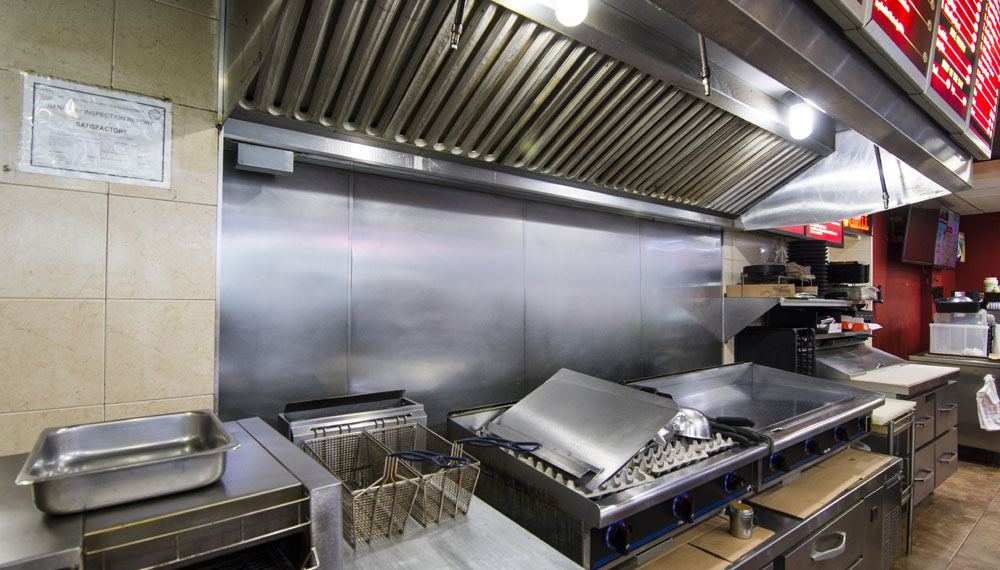Why Kitchen Hood Cleaning Matters
-
Fire Safety:
Grease buildup in kitchen hoods can become a fire hazard. Regular kitchen hood cleaning reduces the risk of sudden flare-ups and ensures your space remains compliant with fire safety regulations. -
Improved Air Quality:
A dirty hood traps smoke, odors, and harmful particulates. Efficient kitchen hood cleaning helps maintain better air circulation and a healthier cooking environment. -
Increased Efficiency:
A clean hood works more effectively, reducing energy consumption. Proper kitchen hood cleaning ensures your exhaust system functions optimally, drawing out heat and smoke quickly. -
Compliance and Inspections:
Commercial kitchens are required to follow strict hygiene and safety standards. Failing to perform regular kitchen hood cleaning could result in hefty fines or even closures during inspections.
Signs You Need Kitchen Hood Cleaning
-
Visible grease buildup on the hood or vents
-
Lingering odors despite using the exhaust fan
-
Excessive smoke while cooking
-
Decreased suction or ventilation performance
-
Increased noise from the exhaust system
If you notice any of these signs, it’s time to schedule a kitchen hood cleaning session.
How Often Should You Clean Your Kitchen Hood?
The frequency of kitchen hood cleaning depends on how often the kitchen is used:
-
Heavy use (e.g., restaurants): Monthly
-
Moderate use: Every 3 months
-
Light use (e.g., home kitchens): Every 6 months
Keeping a schedule ensures you don’t fall behind on this essential maintenance task.
DIY vs Professional Kitchen Hood Cleaning
DIY Cleaning:
For light use, you can handle kitchen hood cleaning yourself by using degreasers and scrubbing the filters and exterior. However, DIY methods may not reach deep-vent areas where grease and grime accumulate.
Professional Cleaning:
For thorough and certified kitchen hood cleaning, professionals use specialized tools to clean internal ductwork, fans, and hoods in compliance with local health and safety standards.
Step-by-Step DIY Kitchen Hood Cleaning
-
Turn Off Power: Safety first—disconnect the power to avoid accidents.
-
Remove Filters: Take out the metal filters and soak them in hot, soapy water.
-
Degrease the Hood: Use a degreasing spray or baking soda paste.
-
Scrub and Rinse: Use a non-abrasive sponge to clean surfaces.
-
Clean the Fan and Duct: If accessible, remove visible grime.
-
Dry and Reassemble: Ensure everything is dry before reconnecting the system.
Even with these steps, professional kitchen hood cleaning is recommended periodically for deeper sanitation.
Benefits of Regular Kitchen Hood Cleaning
-
Enhances kitchen safety
-
Prolongs the life of your ventilation system
-
Keeps your kitchen compliant with regulations
-
Reduces foul odors and smoke
-
Saves money by preventing costly repairs and fire damage
Consistent kitchen hood cleaning is a proactive step toward maintaining a clean, efficient, and safe kitchen.
Final Thoughts
In today’s fast-paced world, it’s easy to overlook kitchen hood cleaning, but doing so can have serious consequences. By establishing a routine and recognizing when professional help is needed, you can protect your kitchen, your health, and your peace of mind.
Make kitchen hood cleaning a part of your regular maintenance checklist—it’s an investment in safety and hygiene that pays off in the long run.









